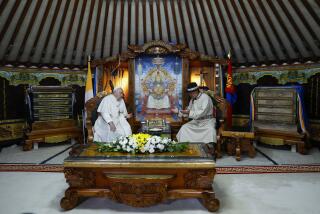Arid Mongolia Yields Troves Under Surface
- Share via
Baga Gazryn Chulu, Mongolia — Archeologists and dinosaur hunters are digging up Mongolia’s vast countryside, seeking to retrace thousands of years of history in this storied but mysterious land.
It was from here that Genghis Khan’s armies conquered China and threatened Europe more than 700 years ago and where herds of dinosaurs once roamed.
“Mongolia is still a big question: Who was where? Who was doing what?” says Jargalan, a 22-year-old archeology student who is working on a tomb dig at Baga Gazryn Chulu in the Gobi Desert. Like many Mongolians, he uses only one name.
“Mongolian archeology is just a baby,” he says.
Mongolia, a former Soviet satellite state, is now a desperately poor country eager for foreign investment. It is welcoming archeology and paleontology expeditions as a way to create jobs and train Mongolia’s growing corps of homegrown scientists.
“Beyond the artifacts, we are trying to build scientific potential,” says Jean-Paul Desroches, head of a French-Mongolian archeological expedition. “That’s the invisible part of what we’re doing.”
In centuries past, European adventurers carted their treasures home. Not anymore. Desroches’ team has uncovered cloth, gold and bronze artifacts from as early as AD 10 that are being restored in France and will be returned to Mongolia to add to its national heritage.
But tomb raiders also are active, seeking to sell treasures to rich foreign collectors. Dinosaur bones are even on offer at Mongolia’s tourist markets, along with official-looking maps of excavation sites.
Officials and nongovernmental groups are reaching out to the country’s poor herders, telling them not to help tomb raiders locate historic finds.
“We are working with the country people to help them understand this is their heritage too,” says K. Tsogtbaatar, head of the paleontological museum and laboratory at the Mongolian Academy of Sciences.
More to Read
Sign up for Essential California
The most important California stories and recommendations in your inbox every morning.
You may occasionally receive promotional content from the Los Angeles Times.













